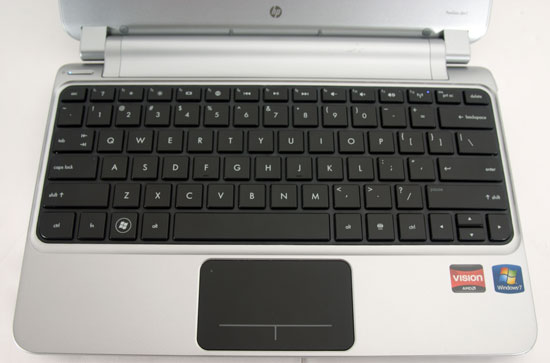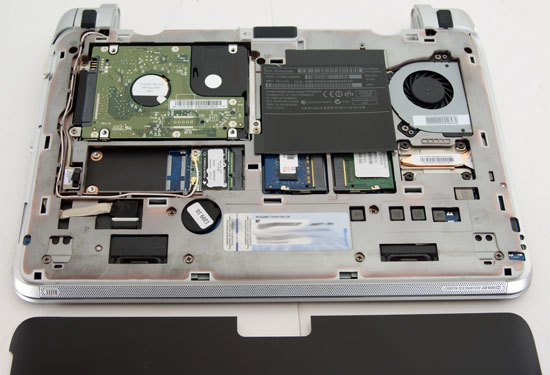HP dm1z: Taking Fusion on the Road
by Dustin Sklavos on February 21, 2011 7:00 PM ESTThe Swankiest Netbook You Ever Did See
First we should make one thing clear: the HP dm1z is basically small enough and slow enough to be considered a netbook, with most of the good and bad connotations that term brings with it. With that in mind, the dm1z is a remarkably attractive piece of kit and as you'll see, in many ways it feels like the netbook finally arriving at about the form factor and performance level it always needed to be at.
The lid of the dm1z is a textured black plastic that is a healthy stride away from the glossy plastic hell that used to plague HP's older models; it's attractive and doesn't easily pick up fingerprints and smudges, and the HP logo is nice and subdued in the lower corner. There's a silver trim that extends around the lid and into the body.
When you pop open the dm1z, you'll see that trim matched with silver matte plastics on the screen bezel and tastefully framing the keyboard and touchpad. HP has made some really great strides as of late in improving the looks of their notebooks, and the dm1z continues that trend. The silver plastic is used for the interior surface along with the battery and rim of the system and is complemented by sparse usage of white LED indicator lights.

HP has been pushing a standardized chiclet-style keyboard across all of their lines at this point, and it suits the dm1z. The 11.6" form factor allows HP to squeeze a comfortable full-sized keyboard into the unit, too, with the document navigation keys helpfully and logically mapped to Fn+arrow key combinations. The keys aren't marked that way, but it's easy enough to figure out. There's no number lock either, but I've never found the 10-key wrangled onto the main keyboard to be particularly useful. The only complaints about the keyboard are minor ones: HP, like Dell, opts to default the function keys to controls and shortcuts (though this can be toggled in the UEFI), and the left and right arrow keys are basically double-sized compared to the up and down arrows. On the whole, though, this is a solid netbook keyboard that most people should be very comfortable with.
The touchpad is more of a mixed bag, but kudos to HP for actually using a separate piece of plastic for it instead of just building the sensor into the inside panel. Of course, there's a reason for that: HP is using the same clickpad that's dogged their mainstream notebooks over the past year. To be fair the HP implementation is among the better ones used for Windows-based systems, it's multitouch capable, and the tracking surface is comfortable, but we would still rather see dedicated buttons on future refreshes. If you're using an external mouse or keep brushing the touchpad (not a problem I had in testing it), you can actually double-tap the top left corner of the touchpad with your finger to disable it; a pinpoint orange LED will glow when the touchpad is disabled.

One of my favorite features of the dm1z is actually on the bottom. HP has gone a long way towards simplifying user upgrades by simply putting one large, screwless panel on the bottom of the unit. The panel simply snaps on and off and feels both sturdy and user-friendly while also making the dm1z as a whole more attractive by hiding serial numbers and the Windows key. As you can see, everything you'd want to upgrade is easily accessible.
Taken as a whole I'll admit to being fairly smitten by the dm1z's design. It's remarkably well streamlined and clearly designed to improve the user experience while avoiding looking too chintzy or cheap. This is definitely one of the best-looking netbooks I've ever seen and it feels very solid.
















108 Comments
View All Comments
Gigantopithecus - Tuesday, February 22, 2011 - link
"When the internet gave everyone a voice, we discovered how few people were actually worth listening to."Halley - Tuesday, February 22, 2011 - link
In my spare time I enjoy listening to music. Music by youtube - 720 or 1080, please - or by Windows Powerpoint .pps files is better sometimes IMHO. Am I better off with a tablet or with this HP dm1z netbook?Reading and replying email must be done, too. Without a keyboard, replying would take more time, I guess.
Tablets are definitely more portable. It's nice to have both - tablet and netbook - but tablets are too expensive to me. If I can afford, I would have both.
cyrusfox - Monday, February 21, 2011 - link
I second this question, is the other mini-PCIe slot msata compatible?nitrousoxide - Monday, February 21, 2011 - link
I am expecting a Fusion-based netbook with USB 3.0 support, slightly larger screen (12.1 or 13.3 inch) with better display quality and really low noise (as noise is a matter of concern with dm1z), 4GB RAM packed in a form factor lighter than 3.2lbs while charging me no more than USD500. dm1z is not a perfect choice, ASUS 1215B(USB 3.0+overclocking) or MSI U270(USB 3.0) may be better but they are not shipping at this point. One thing I worry about 1215B is upgrade flexibility as 1215N is extremely hard to disassemble so this may be a problem `cuz I want to install an SSD on it. Hope to see more Fusion-based netbook reviews.Impulses - Tuesday, February 22, 2011 - link
I'm right there with ya... Gimme USB 3.0 plus maybe a slightly larger battery and/or screen and I'm sold, though I'd take 11.6" over 13.3", 12" would be ideal. I don't even care if it's a pain to disassemble, I did it with my 1st gen Acer netbook (to install an X25-V), I don't mind going thru it again if everything else (ports, screen, noise) is ideal. Neither the dm1z (couple of small compromises, and frankly I don't care for the aesthetics) nor the X120 (somewhat overpriced) have struck that perfect balance so until then I'll stick to my current netbook.QChronoD - Monday, February 21, 2011 - link
Maybe I'm not the typical gamer, but I wouldn't even bother trying to play something that only gets 15 or 20fps on the lowest settings. Looking to replace my old 1.2GHz C2D machine and want to be able to game a little when I have an hour or two between classes.I'm more interested in how it scores on some of the older and less demanding games? I would assume that it can play games from 3-4 years ago much better than the ones that you have benchmarked.
I don't think we'd need exact numbers, but would it be possible to test this level of machine with some older games and just give us a report on whether they ran smoothly at around medium settings? Maybe also test a few of the more demanding flash games, and possibly minecraft.
JarredWalton - Monday, February 21, 2011 - link
I'm working on it with the MSI X370... you'll notice the last paragraph on the gaming page mentions additional testing. HL2 runs okay, though EP2 starts to get sluggish. Quake 4 is another title that runs fine. I figure anything from before that time will also be good, so maybe grab the original Deus Ex (with the enhancement mod) while you're at it. :-)QChronoD - Monday, February 21, 2011 - link
Sorry Jarred, reading comprehension fail on my part.Keep up the good word on your reviews.. definitely the best in the business!
Powerlurker - Tuesday, February 22, 2011 - link
If you're a gamer, you probably wouldn't be looking at a netbook in the first place. The extra graphics horsepower in Brazos is mostly intended for things like video decoding and Flash acceleration.MonkeyPaw - Monday, February 21, 2011 - link
I looked at this very netbook at a local store, and I saw that it came with 71 services running from the factory. It's such a disservice what OEMs do to machines. I can't imagine any machine would feel responsive with that much running in the background. Though I am impressed with the 7200rpm drive on a netbook.Did you do a clean install for your tests?